Photo



hey, remember this post? well, i thought it was kind of a fun idea and that it would make a cute gift for my greek professor who has been really fantastic to me this semester, so here y’all go: The Very Angry Achilles. you can read the rest under the cut!
Keep reading
3K notes
·
View notes
Text











Ex Roma Ad Tempus #5 (“Io Saturnalia”) (1/2) Lineart (no color/rendered background) (forgot to add plant in the pot in page 4)
#erat05#oc#original comic#web comic#webtoon#comics#graphic novel#original character#ancient rome#ancient egypt#ancient greece#history#time travel#mythology#archaeology#exromaadtempus#saturnalia#roman empire#ex roma ad tempus#sigillaria#pileus#rome
1 note
·
View note
Text












Ex Roma Ad Tempus #5 (“Io Saturnalia”) (2/2) Lineart (no color/rendered background)
#erat05#oc#original comic#web comic#webtoon#comics#graphic novel#original character#ancient rome#ancient egypt#ancient greece#history#time travel#mythology#archaeology#saturnalia#roman empire#ex roma ad tempus
1 note
·
View note
Text




Ex Roma Ad Tempus #4.5 (Hair/Fashion) Bibliography
#erat04.5#ex roma ad tempus#oc#original character#original comic#web comic#comics#haircut#archaeology#ancient rome#roman empire
1 note
·
View note
Text
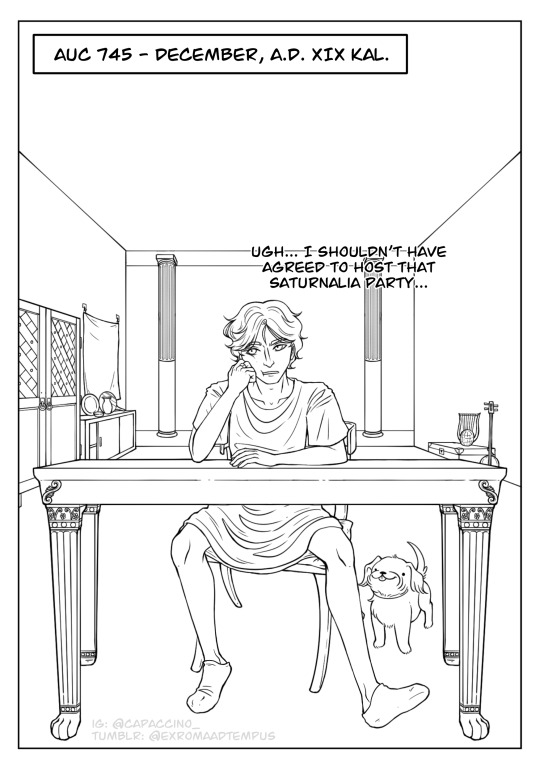
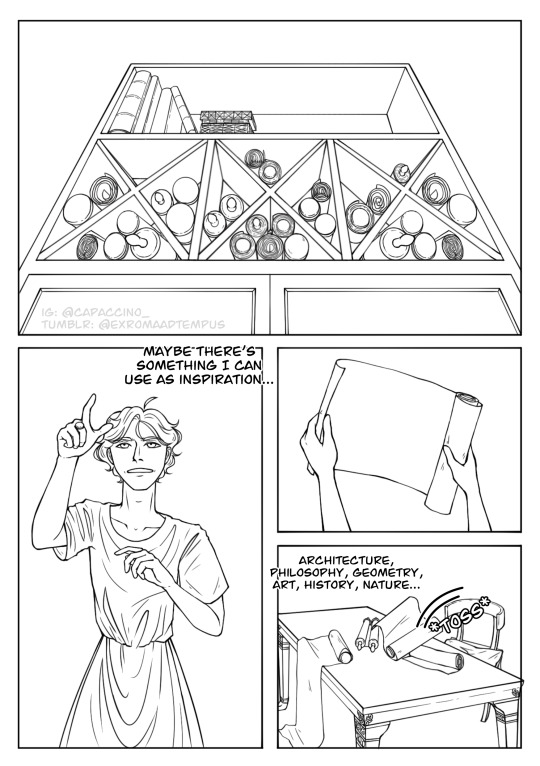
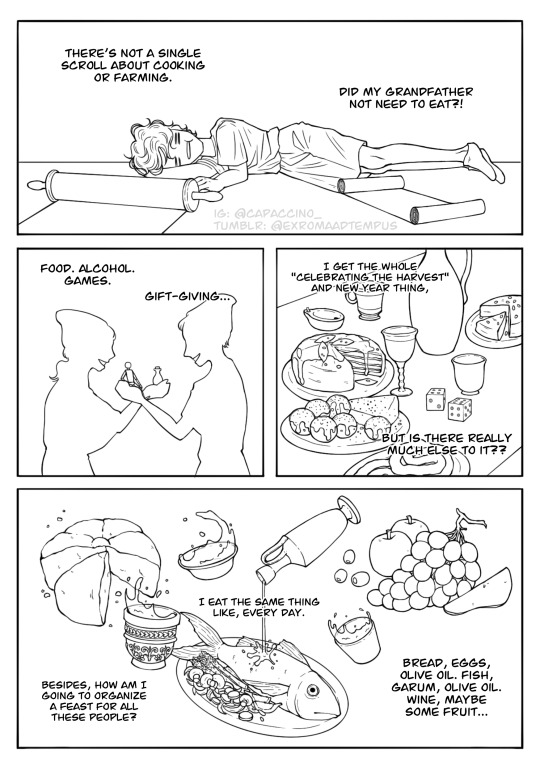
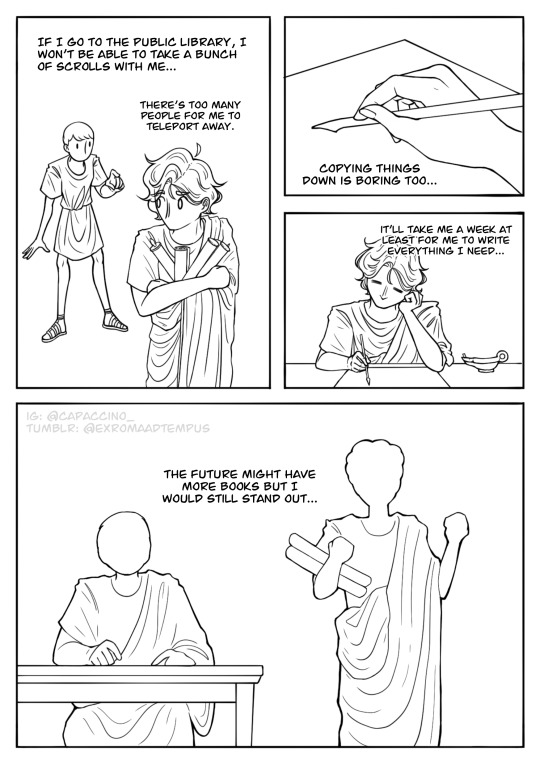
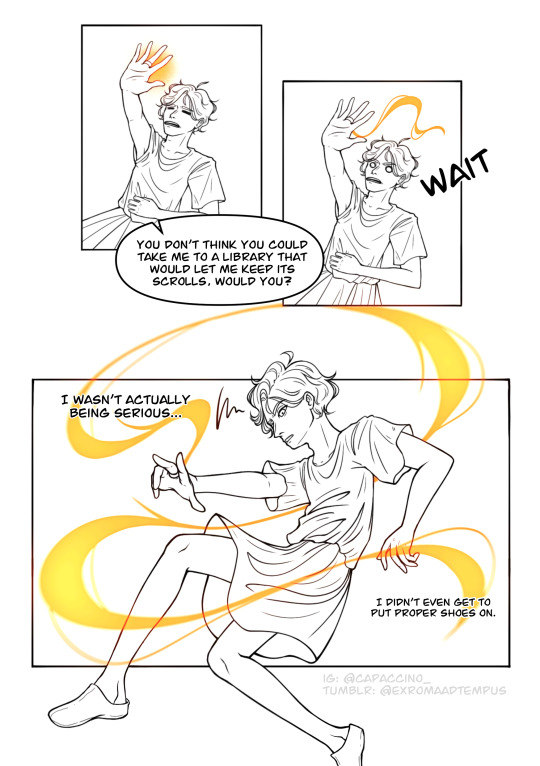
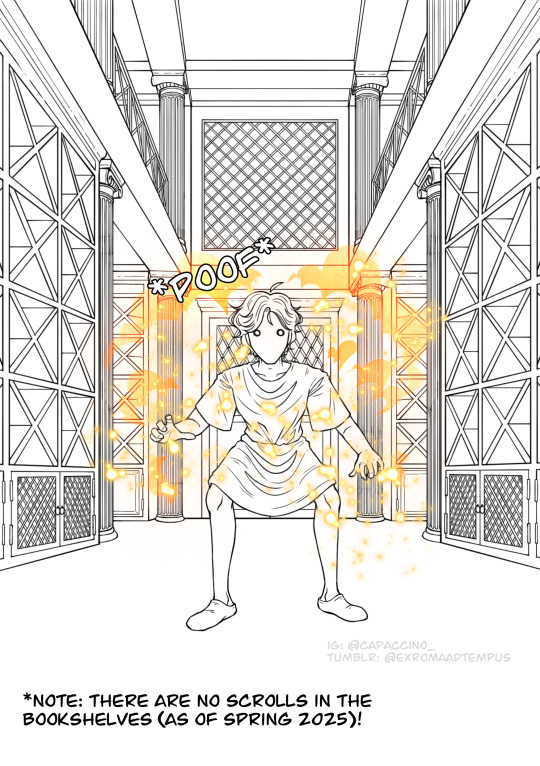
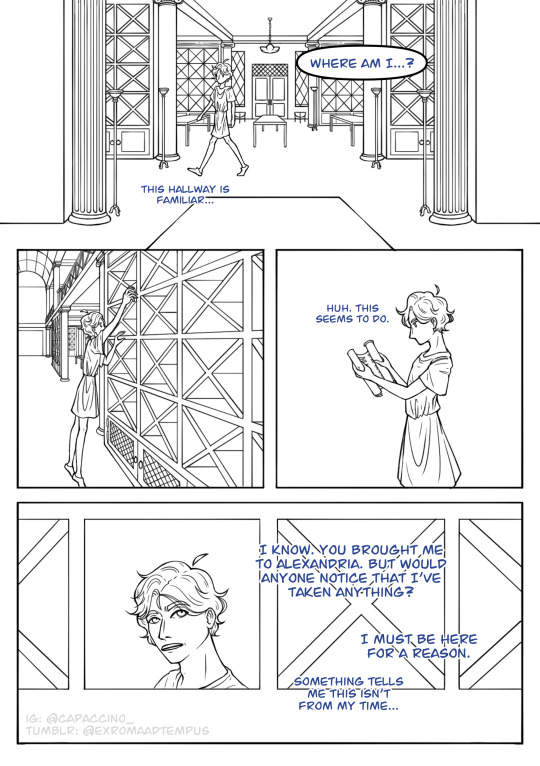
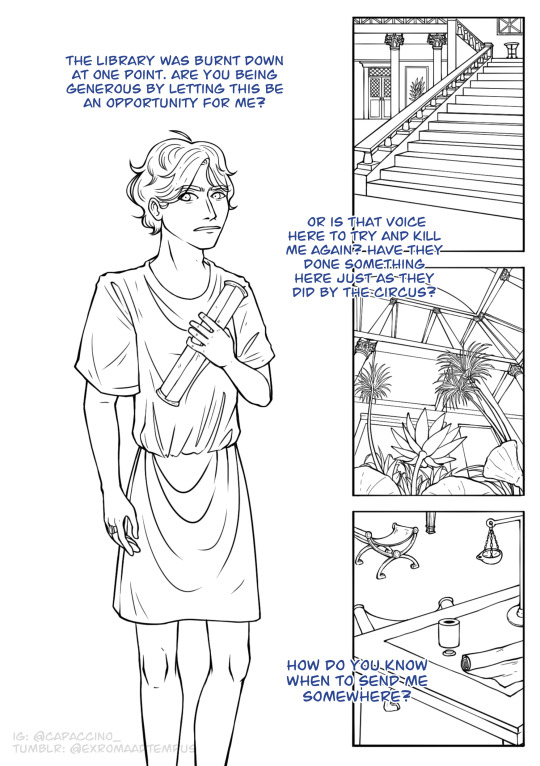
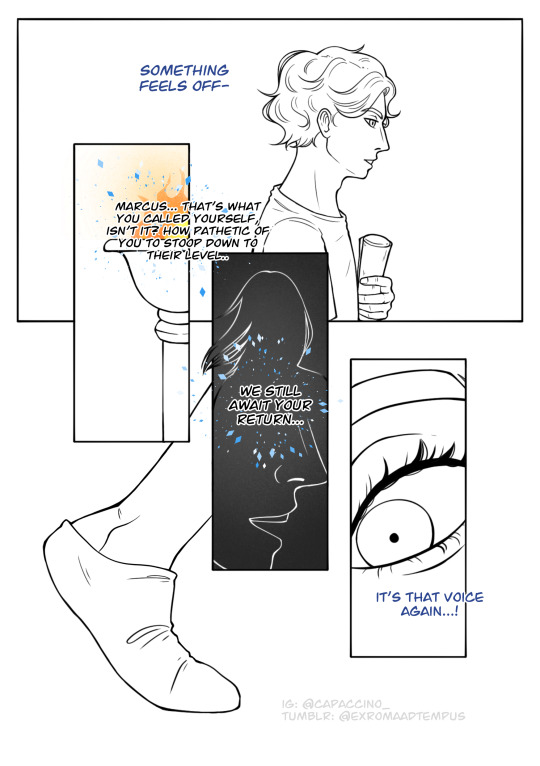
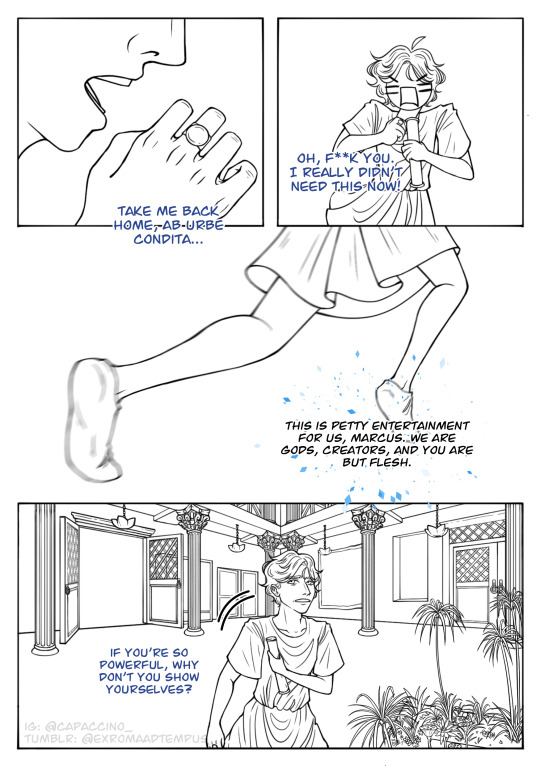
Ex Roma Ad Tempus #4 (Ardent Quest) (1/3) Lineart (no color/background)
#erat04#oc#original comic#web comic#webtoon#comics#graphic novel#original character#ancient rome#ancient egypt#ancient greece#history#time travel#mythology#egyptian mythology#library of alexandria#archaeology#ex roma ad tempus#serpopard#set animal#fantasy#sci fi
2 notes
·
View notes
Text


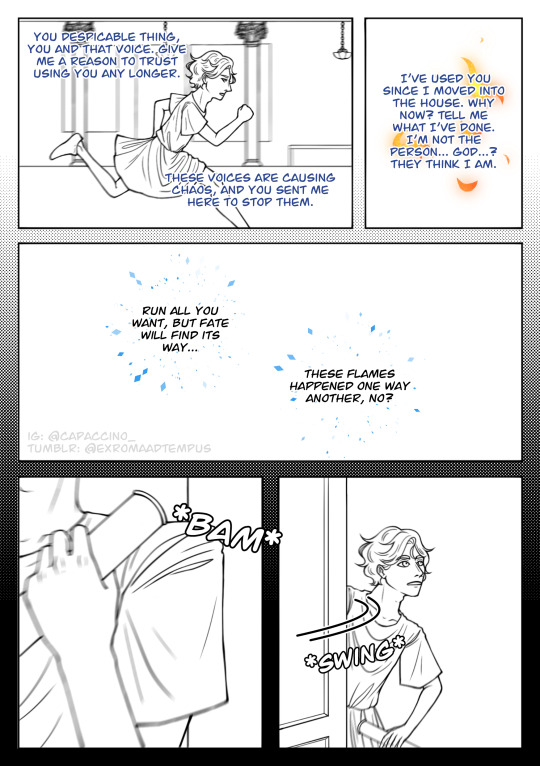



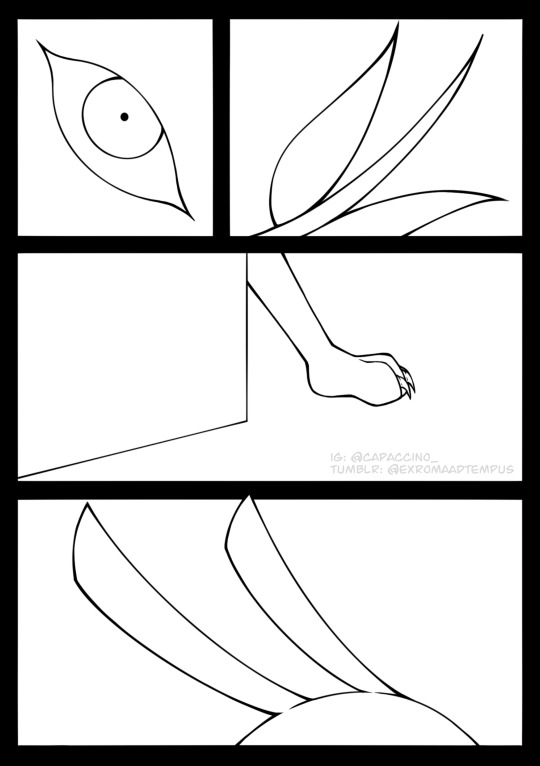
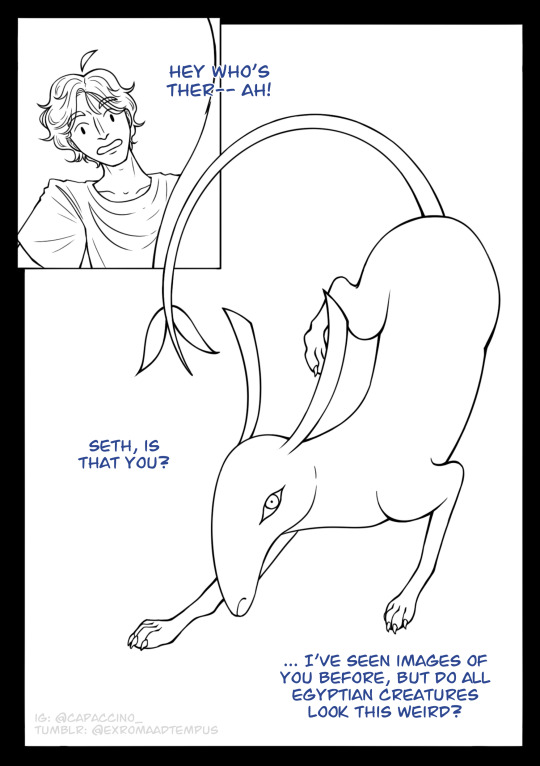
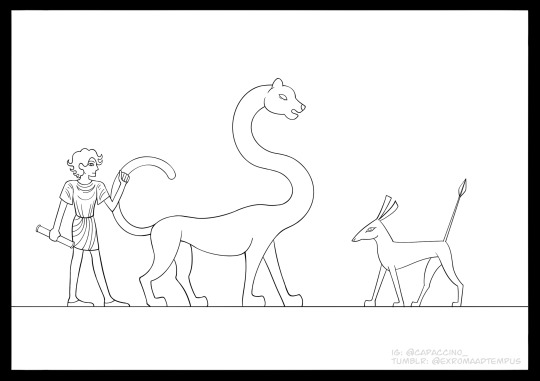
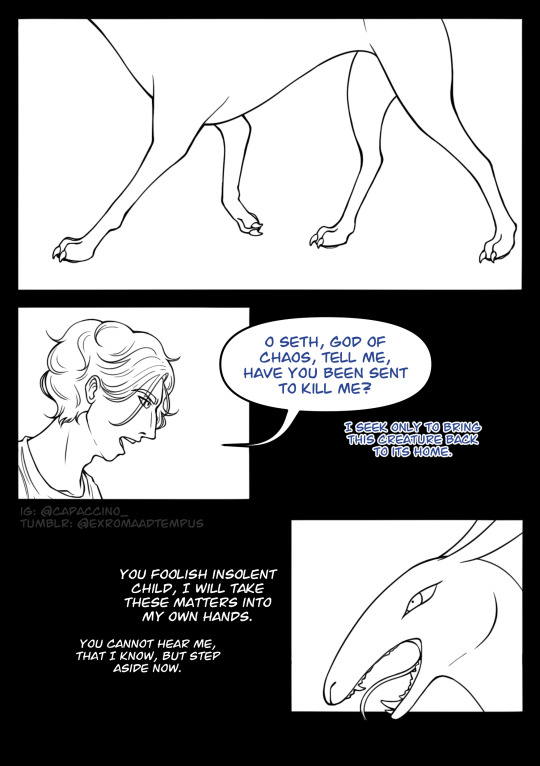
Ex Roma Ad Tempus #4 (Ardent Quest) (2/3) Lineart (no color/background)
#erat04#oc#original comic#web comic#webtoon#comics#graphic novel#original character#ancient rome#ancient egypt#ancient greece#history#time travel#mythology#egyptian mythology#library of alexandria#archaeology#ex roma ad tempus#serpopard#set animal#fantasy#sci fi
4 notes
·
View notes
Text










Ex Roma Ad Tempus #4 (Ardent Quest) (3/3) Lineart (no color/background)
#erat04#oc#original comic#web comic#webtoon#comics#graphic novel#original character#ancient rome#ancient egypt#ancient greece#history#time travel#mythology#egyptian mythology#library of alexandria#archaeology#ex roma ad tempus#serpopard#set animal#fantasy#sci fi
1 note
·
View note
Text














Ex Roma Ad Tempus #3 (Silphium Stealers) (1/2) Reformatted from Webtoon (modified dialogue)
#erat03#oc#original comic#web comic#webtoon#comics#graphic novel#original character#ancient rome#ancient egypt#ancient greece#history#time travel#mythology#archaeology#roman empire#silphium#pegasus#mythical creatures#ex roma ad tempus#sci fi#fantasy
2 notes
·
View notes
Text













Ex Roma Ad Tempus #3 (Silphium Stealers) (2/2) Reformatted from Webtoon (dialogue altered)
#erat03#oc#original comic#web comic#webtoon#comics#graphic novel#original character#ancient rome#ancient egypt#ancient greece#history#time travel#mythology#archaeology#roman empire#silphium#pegasus#mythical creatures#ex roma ad tempus#sci fi#fantasy
1 note
·
View note
Text













Ex Roma Ad Tempus #2 (Don't Play With Fire) (1/2) Reformatted/rewritten from Webtoon
#erat02#oc#original comic#web comic#webtoon#ancient rome#roman empire#ancient greece#mythology#mythical creatures#chimera#rome#ex roma ad tempus#original character#salamander#archaeology#time travel#sci fi#fantasy#history
3 notes
·
View notes
Text














Ex Roma Ad Tempus #2 (Don't Play With Fire) (2/2) Reformatted/rewritten from Webtoon
#erat02#oc#original comic#web comic#webtoon#ancient rome#roman empire#ancient greece#mythology#mythical creatures#chimera#rome#ex roma ad tempus#original character#salamander#archaeology#time travel#sci fi#history#fantasy
3 notes
·
View notes
Text








Ex Roma Ad Tempus #1 ("The Emperor Loves His Horse") (1/2) Lineart (no color)
Bibliography
#erat01#webcomic#webtoon#ancient rome#oc#graphic novel#digital art#fantasy#scifi#history#classical studies#original comic#roman art#archaeology#caligula's horse#time travel#ex roma ad tempus#i keep forgetting to reverse the seal on the ring
3 notes
·
View notes
Text







Ex Roma Ad Tempus #1 ("The Emperor Loves His Horse") (2/2) Lineart (no color)
Bibliography
#erat01#webcomic#webtoon#ancient rome#oc#graphic novel#digital art#fantasy#scifi#history#classical studies#original comic#roman art#archaeology#emperor caligula#caligula's horse#time travel#ex roma ad tempus
2 notes
·
View notes
Text
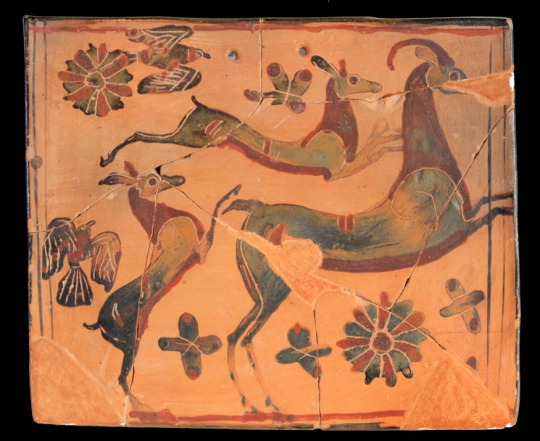
painted tablet depicting a doe with her fawns, dedicated to the Sanctuary of Nymphe, protectress of marriage | c. 600 - 575 BCE | greece, archaic period
in the acropolis museum collection
451 notes
·
View notes
Text
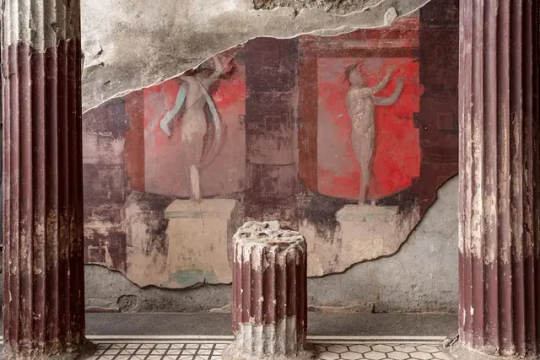





The "Dionysian fresco,"
Dubbed the "house of Thiasos" by archaeologists, was unearthed from a banquet hall amid excavations to Insula 10 Regio IX in Pompeii.
All images courtesy Parco Archeologico di Pompei
2K notes
·
View notes
Text
05 – Io Saturnalia
Preface
This chapter introduces Val’s family in the context of Saturnalia, a time of gathering, fun, and rejection of social norms (e.g., slave/master, men/women, adult/child dynamics). Valentinus comes from a peculiar family, whose background even he is not fully familiar with. During the party, his parents make an unexpected visit, catching the attention of Val’s guests– his mother and father carry themselves unconventionally, both in appearance and character, in contrast to the rest of the crowd. The magic system of Ex Roma also begins to formally reveal itself starting with this chapter, which borrows from concepts such as divination, charms, witchcraft, and theurgy and combines them with godlike abilities (e.g., shapeshifting).
After exchanging gifts, Val notes his father’s tolerance of and tendency to adopt foreign customs, particularly of Egyptian culture as suggested by his newly acquired wedjat amulet necklace. The integration and recognition of foreign cultures is notable in Roman culture– as the series continues, I seek to emphasize Val’s connection with foreign cultures in contrast with the homogeneity of “Roman-ness”. While Romans readily borrowed and honored Greek artistic and religious customs (e.g., architectural techniques, clothing, dining, gods), Egyptian culture, being more ancient and foreign from a Roman perspective, was not held to the same standards (largely socio-political reasons) but was more or less acknowledged. Val’s “peculiar” (family) dynamic and knowledge grows as he interacts with new cultures and time periods spanning across Asia and Africa, which eventually point him toward his family origins and the whereabouts of his sister, Lucia.
Saturnalia:
Saturnalia was a festival celebrated in mid-December from the 17th to 23rd (by the 1st century BCE) in honor of Saturn, the god of time and agriculture. This was a time of feasting, gift-giving, and the reversal of roles and social norms. People engaged in games and gambling and were open to free speech and mockery. Slaves were also treated as equals– Roman citizens wore the pilleus, a conical felt hat that traditionally marked the freedman status of manumitted slaves. The synthesis (1) (σῠ́νθεσῐς, “a putting together”)/cenatoria (2) (“dinner clothes/robes”) was a loose colorful garment worn by both men and women for dining or special occasions such as Saturnalia. The exact physical composition of syntheses is not clear but is suggested to be some sort of robe or informal tunic-and-toga-like combination.
(Note: everyone in this episode is wearing a tunic rather than a synthesis– I should have changed this earlier on in the drawing process but the lineart alone probably would not have brought the historical accuracy justice compared to if it were colored anyway).
(Cassius Dio on Nero’s dress, Roman History, LXII.13)
Examples of gifts: hats, balms, canes, cups, birds, cloaks, tablets, lyres, “Livy in a single volume” (in membranis), dwarf mules, dogs, sigillaria (Martial, Epigrams, Book 14).
Quotes on Saturnalia:
“Come on, then, use the freedom December allows, since our ancestors wished it: speak!” (Horace, Satires, 2.7)
“Among our ancestors the Saturnalia was confined to one day, the fourteenth before the Kalends of January, but after Gaius Caesar gave the month two more days, it began to be celebrated on the sixteenth day before the Kalends. [...] though note that even among the ancients there was the opinion that the Saturnalia spanned seven days” (Macrobius, Saturnalia, 1.10.2)
“On the Saturnalia [...] [Augustus] would now give gifts of clothing or gold and silver; again coins of every device, including old pieces of the kings and foreign money; another time nothing but hair cloth, sponges, pokers and tongs, and other such things under misleading names of double meaning.” (Suetonius, The Lives of the Caesars – Life of Augustus, 75)
Page-by-Page Notes
Page 1
Val wears a pilleus and holds a terracotta modiolus (cup with a handle, wine not pictured).
Pilleus – a conical cap made of felt that originated in Ancient Greece. In Rome, pillei were worn by manumitted slaves. Romans of all social statuses donned pillei during Saturnalia, representing the reversal of roles.
Martial’s Epigrams (on Saturnalia)
“Now, while the knights and the lordly senators delight in the festive robe, and the cap of liberty is assumed by our Jupiter” (XIV.1)
“In these festive days of the scythe-bearing old man, when the dice-box rules supreme, you will permit me, I feel assured, cap-clad Rome, to sport in unlaboured verse. You smile: I may do so then, and am not forbidden. Depart, pale cares, far away from hence; let us say whatever comes uppermost without disagreeable reflection. Mix cup after cup, my attendants [...] I can do nothing without wine; but, while I am drinking, the power of fifteen poets will show itself in me” (XI.6)
Page 2
Val’s biclinium got converted into a triclinium
The people in the bottom right panel are playing tali, a dice game.
Garlands/festoons (serta, -ae; f) were made using leaves (e.g., acanthus, laurel, bay), flowers, and fruits (e.g., apples, pomegranates, grapes).

Closeup of garlands in southeast triclinium of the House of the Vettii painted in the fourth style, mid-1st century CE, fresco, Pompeii.

Wall painting from the west wall of Room L of the Villa of P. Fannius Synistor at Boscoreale, c. 50–40 BCE, fresco, Roman, now in the Metropolitan Museum of Art. https://www.metmuseum.org/art/collection/search/247008.
Other examples of garlands: (1) (2)
Page 3
An oil lamp (bottom left)
2 small drawstring sacks of stuff (gifts)
Page 4
Birds are related to omens, good and bad. The word “auspicious” comes from auspicium (“bird-watching”), which involves observing the movement and the type of bird to draw a favorable/unfavorable outcome.
Glass pitchers, various cups (Etruscan, British, Egyptian, Chinese, terra sigillata), and bottles
Pot with laurel, roses, chamomile
Page 5
Know-it-all trope
Foods (center bottom panel – top to bottom): Libum, placenta, globi, encytum
A strigillated (repeated S-shaped flutes/shallow grooves) pitcher
Some non-Roman cups (Sogdian fluted cup, chalice, Chinese wine cup)
Page 6
Sempronia is represented by a screech owl (ulula) and Sextus by a raven (corvus)
Page 7
Skin/face cream and perfume bottle
Reference (perfume bottle): (1) (2)
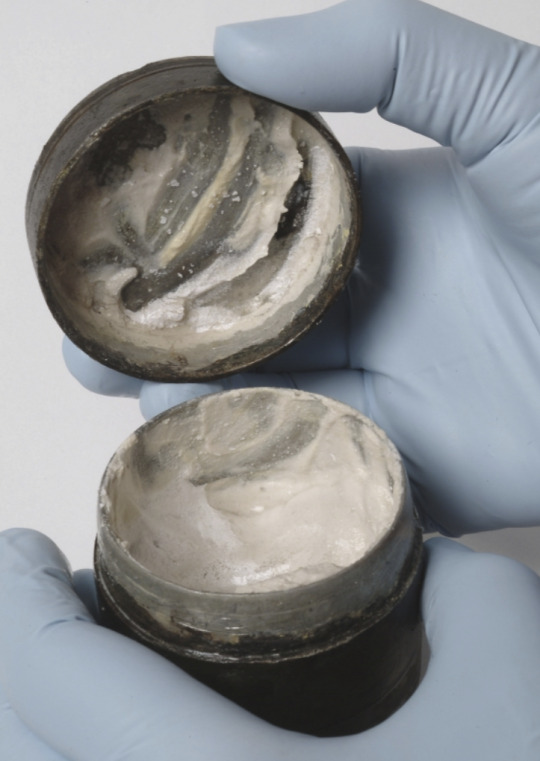

Face cream in tin alloy canister, c. 100-150 CE, London. https://www.londonmuseum.org.uk/collections/v/object-727368/tin-tin-alloy-canister/.
Page 8 (notes in progress)
To clarify, the sparkles indicate whenever something magical happens. Valentinus’ parents (Vitalinus and Laura) naturally have magic (as suggested by Curio, who notes that they have a “charm” to them). Val’s magic works when he comes in physical contact with someone/thing whilst using speech.
Theurgy (θεουργία) – communication with spirits and deities, involves rituals of ascetic disciplines (prayers, dances, meditation, etc.) and/or external influences/tools (drugs, perfumes, light) to connect with higher powers
Goetia (γοητεία) – witchcraft, may involve the utilization of instruments such as wands, curse tablets (tabella defixionis, κατάδεσμος) or texts, and amulets.
Divination (divinatio, -is) – foresight
Laura (and Lucia’s) power.
Charms (physical, magical) (fascinum, -i)
Val and Vitalinus’ powers are based on blandimentum (flattery, allure, charm)
Magicians, religion, and healing (Pliny, Natural History, XXX)
Page 9
Val’s gifts were originally supposed to be wooden dolls, I felt that clay Sigillaria were more fitting given the holiday
The gifting of Sigillaria usually marks the end of Saturnalia, which Macrobius (Saturnalia, 1.10.24) notes extended the celebration to seven days (i.e., December 23rd).
Sigillarium (-a): a pottery or wax figurine often made in the likeness of a divinity, mythological/fantastical figure, or animal (or in this case, anything at all, really).
Page 10
Vitalinus’ sigillarium is holding a cabbage! Farming was an idealized occupation as its “simplicity” promoted a virtuous and stable way of life (hi, Cincinnatus and Cato the Elder). Cabbage was believed to have all-encompassing health benefits from promoting digestion to healing wounds (Cato, De Agricultura, 156-157).
Shocked marble statue gag
The parents canonically have even more statuettes and figurines lying around.
Lar (pl: lares): a protective household spirit/guardian deity believed to protect and watch over the space they were displayed in.
Page 12
Panel with a sparrow on a branch looks awkward because there’s supposed to be a colored background.
A fountain with a lion head spout
Page 13
Val wears a bulla (circular protective amulet worn by boys until they come of age)
Girl’s equivalent: lunula (moon/crescent shaped)
Page 15
Lucia takes the female form of Vitalinus’ praenomen (whereas Val takes his grandfather’s)
Women often took the female form of the gens nomen (like Sempronia). Both Val and Lucia’s cases are less common.
Page 16
“Parthian-style” chicken with stuffed dates and apricots, grapes
Greek lekythos (λήκυθος) (olive oil container)
Bird-head pitcher (without a design on the belly)
Other examples: (1) (2)
Page 17
Egyptians legally did not have equal status to Roman citizens but were accepted into/layered onto Greco-Roman culture and identity. Romans would have been cognizant of Egyptian culture/religion (and given that Roman tourist travels included Egypt).
Ancient tourists bought souvenirs on their travels– Casson (1994) notes “a distinctive type of cheap faience pot with a figure in relief on it of one of the Ptolemaic queens” which “appealed to visitors, who carried them off as souvenirs”.
Page 19
Vitalinus (tries to) use his magic powers on Val and Laura notices.
Page 20
Glass mosque lamp and mirror (left side)
Reference (lamp): (1) (2)
Bookshelf not filled now (April 2025)
Page 23
The dimension that Val falls into has Roman, Greek, and Egyptian columns
Roman: stacked drums (fluted) or monolithic (smooth)
Greek: stacked drums (fluted)
Egyptian: stacked drums (with relief)
Tableware
Terra sigillata was a type of mass-produced red pottery with shiny surface slips and intricate relief designs. Distinct products include Arretine ware (produced in Arezzo/Italy), Samian ware (Gaul), and African red slip ware (North Africa).

Arretine ware: cups and plate, 20-40 CE, Italian red slip ware, Arezzo, made by the potter Inachus. https://www.britishmuseum.org/collection/object/G_1814-0704-1554.
Featured tableware obviously not from Rome (or Val’s time period)

Chinese wine cup from Tang dynasty (late 7th century CE) and Sogdian cup (7th century CE), metal. https://sogdians.si.edu/sidebars/sogdian-metalworking/.
Val’s parents (Vitalinus and Laura) references

Portrait of Gaius Cassius Longinus (originally thought to be Gnaeus Domitius Corbulo), 1st century BCE, Parian marble, Rome, Musei Capitolini Centrale Montemartini. Female portrait, c. 1-10 CE, Parian marble, Rome, Musei Capitolini Centrale Montemartini.

Funerary relief with two spouses, c. 50 BCE, limestone, Rome (via Statilia). https://www.centralemontemartini.org/it/opera/rilievo-funerario-di-due-coniugi-da-statilia.
Valentinus’ Saturnalia Menu:
Cato the Elder’s De Agri Cultura (c. 160 BCE)
(Marcus Gavius) Apicius’ De Re Coquinaria (c. 1st century CE or 5th century CE)
(Include olive oil as needed)
Pastries
Classic bread
Libum (cheesecake-bread with pine nuts and honey)
Placenta (“cheesecake”– cheese and dough layers wrapped in a crust and flavored with bay leaves and honey)
Spira (a baked spiral cheese pastry)
Scriblita (honey-less placenta; like a pancake)
Globi (fried cheese balls with poppy seed and honey drizzle)
Encytum (fried funnel cake glazed with honey)
Fish
Butter-basted broiled lobster with pepper and coriander sauce
Stuffed calamari
Raw oysters with pepper and lovage
Sea urchin with liquamen/garum
Steamed stuffed sardines and baby tunny
Sauces
Laser/silphium sauce (flavoring)
Also comes from Parthia
Peas/beans with yolks and laser sauce
(Indian peas) Peas with leeks and minced cuttlefish flavored with wine
Braised Parthian-style chicken with laser and wine
(ius alexandrinum in pisce asso) Alexandrian sauce
Boiled colocasia (Egyptian bean root– taro/dasheen)
Desserts
Watermelon/honey melon with parsley and pepper, seasoned with salt and silphium
Stewed honey dates with ground nuts (stuffed dates)
Pancakes served with honey and pepper
Fruit:
Apples, grapes, pears, pomegranates, dates
Blackberries, strawberries
Peaches, apricots (introduced in early empire)
Citrons, lemons, oranges (expensive, imported later on)

Fresco of bread, fruits, and wine cup on a tray found in the atrium of a house (IX.10), c. 1st century BCE- 1st century CE, Pompeii. https://pompeiisites.org/en/comunicati/pompeii-a-still-life-discovered-by-the-new-excavations-of-regio-ix/.

Fresco of hanging fawn and fish with basket of shellfish in the Casa del Tiaso (House of Thiasus), c. 40-30 BCE. https://pompeiisites.org/en/comunicati/pompeii-discovery-of-a-room-with-frescoes-depicting-the-initiation-into-the-mysteries-and-the-dionysiac-procession/#&gid=1&pid=3.
Bibliography (in progress)
Apicius. Cooking and Dining in Imperial Rome. Translated by Joseph Dommers Vehling. Dover Publications, 1977. https://www.gutenberg.org/files/29728/29728-h/29728-h.htm.
Caneva, Giulia and Lorenza Bohuny. “Botanic analysis of Livia’s villa painted flora (Prima Porta, Roma).” Journal of Cultural Heritage 4, no. 2 (2003): 149-155. https://doi.org/10.1016/S1296-2074(03)00026-8.
Casson, Lionel. Travel in the Ancient World. United Kingdom: Johns Hopkins University Press, 1994.
Cato the Elder. De Agri Cultura, LXXIV‑XC. Edited by Bill Thayer. University of Chicago, 2012. https://penelope.uchicago.edu/thayer/e/roman/texts/cato/de_agricultura/e*.html.
Grout, James. “Saturnalia.” Encyclopaedia Romana. Accessed December 17, 2024. https://penelope.uchicago.edu/encyclopaedia_romana/calendar/saturnalia.html.
Luck, Georg. Arcana Mundi: Magic and the Occult in the Greek and Roman Worlds: A Collection of Ancient Texts. Johns Hopkins University Press, 2006.
Martial. Epigrams, Book XIV. Translated by D. R. Shackleton Bailey. Cambridge, MA: Harvard University Press, 1993. https://www.loebclassics.com/view/martial-epigrams/1993/pb_LCL480.229.xml
Pantke, Micaela. “Antique Roman Dishes - Collection”. July 22, 1993. https://www.cs.cmu.edu/~mjw/recipes/ethnic/ancient-rome/index.html.
Pliny the Elder. 1855. The Natural History. Translated by John Bostock and Henry T. Riley. Red Lion Court, Fleet Street, London: Taylor and Francis.
Rogers, Dylan. "The Hanging Garlands of Pompeii: Mimetic Acts of Ancient Lived Religion" Arts 9, no. 2 (2020): 65. https://doi.org/10.3390/arts9020065.
Roller, Matthew B. “Dining Men: Posture, Leisure, and Privilege.” Dining Posture in Ancient Rome: Bodies, Values, and Status, 15–95. Princeton University Press, 2006. https://doi.org/10.2307/j.ctt1p0vjp4.7. Rowlandson, Jane. “Dissing the Egyptians: Legal, Ethnic, and Cultural Identities in Roman Egypt.” Bulletin of the Institute of Classical Studies. Supplement, no. 120 (2013): 213–47. http://www.jstor.org/stable/44216745.
Rowlandson, Jane. “Dissing the Egyptians: Legal, Ethnic, and Cultural Identities in Roman Egypt.” Bulletin of the Institute of Classical Studies. Supplement, no. 120 (2013): 213–47. http://www.jstor.org/stable/44216745.
0 notes



